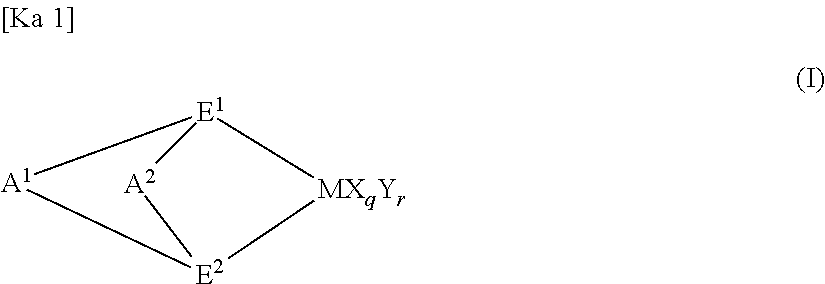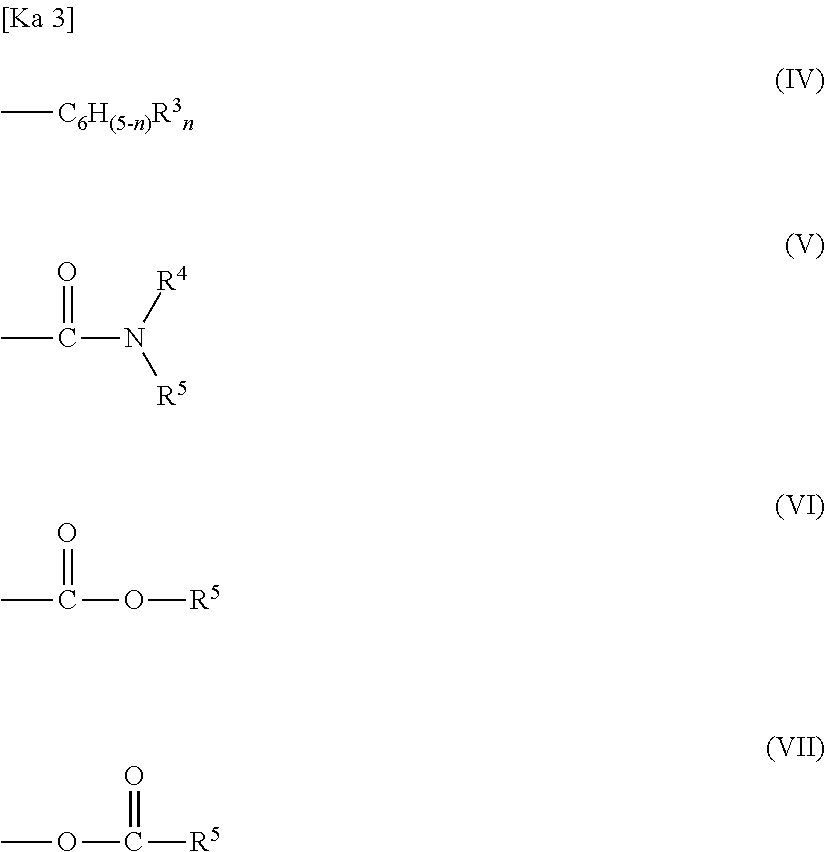Engineering plastic resin composition containing graft copolymer
- Summary
- Abstract
- Description
- Claims
- Application Information
AI Technical Summary
Benefits of technology
Problems solved by technology
Method used
Image
Examples
production example 1
Production of Reactive Polypropylene
(1) Synthesis of Metal Complex
[0326](1,2′-Dimethylsilylene)(2,1′-dimethylsilylene)-(indenyl)(3-trimethylsilylmethylindenyl)zirconium dichloride was synthesized in the following manner.
[0327]A Schlenk bottle of 200 ml was charged with 50 ml of ether and 3.5 g (10.2 mmol) of (1,2′-dimethylsilylene)(2,1′-dimethylsilylene)bisindene under nitrogen flow, and a hexane solution (1.60 mole / liter, 12.8 ml) of n-butyllithium (n-BuLi) was dropwise added thereto at −78° C. The mixture was stirred at room temperature for 8 hours, and then the solvent was removed by distillation, followed by drying the resulting solid matter under reduced pressure, whereby 5.0 g of a white solid matter was obtained. This solid matter was dissolved in 50 ml of tetrahydrofuran (THF), and 1.4 ml of iodomethyltrimethylsilane was dropwise added thereto at room temperature. Hydrolysis was carried out by adding 10 ml of water, and the organic phase was extracted with 50 ml of ether. Th...
production example 2
Production 2 of Reactive Polypropylene
(1) Synthesis of Metal Complex
[0333](1,2′-Dimethylsilylene)(2,1′-dimethylsilylene)-bis(3-trimethylsilylmethylindenyl)zirconium dichloride was synthesized in the following manner.
[0334]A lithium salt 3.0 g (6.97 mmol) of (1,2′-dimethylsilylene)(2,1′-dimethylsilylene)-bis(indene) was dissolved in 50 ml of THF (tetrahydrofuran) in a Schlenk bottle, and the solution was cooled down to −78° C. Iodomethyltrimethylsilane 2.1 ml (14.2 mmol) was slowly dropwise added thereto and stirred at room temperature for 12 hours.
[0335]The solvent was removed by distillation, and 50 ml of ether was added thereto, followed by washing the solution with a saturated ammonium chloride solution. After separating the solution, the organic phase was dried, and the solvent was removed by distillation, whereby 3.04 g (5.88 mmol) of (1,2′-dimethylsilylene)(2,1′-dimethylsilylene)-bis(3-trimethylsilylmethylindene) was obtained (yield: 84%).
[0336]Next, a Schlenk bottle was charg...
production example 3
Production 1 of Graft Copolymer
[0344]A glass-made separable flask of 5 liter equipped with a stirring device was charged with 500 g of the reactive polypropylene produced in Production Example 1 and 1000 ml of dehydrated toluene to dissolve it while stirring at 70° C. Methyl acrylate 219 g and glycidyl methacrylate 322 g were slowly added thereto. Then, 83 ml of toluene in which 2 g of azobisisobutyronitrile was dissolved was added thereto in 2 hours, and after adding, they were reacted at the above temperature for 4 hours.
[0345]After finishing the reaction, a whole mount of the reaction mixture was transferred into a Teflon (registered trade name)-coated bat and dried in air, and then it was heated for 10 hours in a vacuum oven of 85° C. to remove the unreacted monomers and toluene. As a result thereof, 1029 g of a graft copolymer was obtained.
[0346]The copolymer was extracted with acetone to result in finding that a graft rate thereof was 70.8%. Further, a disappearance rate of th...
PUM
| Property | Measurement | Unit |
|---|---|---|
| Fraction | aaaaa | aaaaa |
| Percent by mass | aaaaa | aaaaa |
| Percent by mass | aaaaa | aaaaa |
Abstract
Description
Claims
Application Information
 Login to View More
Login to View More - R&D
- Intellectual Property
- Life Sciences
- Materials
- Tech Scout
- Unparalleled Data Quality
- Higher Quality Content
- 60% Fewer Hallucinations
Browse by: Latest US Patents, China's latest patents, Technical Efficacy Thesaurus, Application Domain, Technology Topic, Popular Technical Reports.
© 2025 PatSnap. All rights reserved.Legal|Privacy policy|Modern Slavery Act Transparency Statement|Sitemap|About US| Contact US: help@patsnap.com



